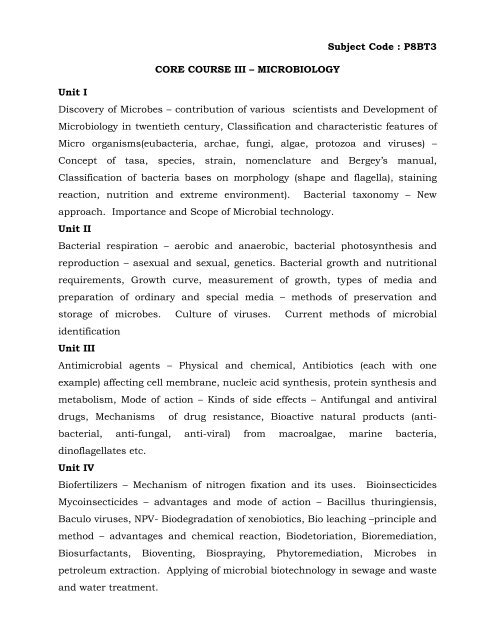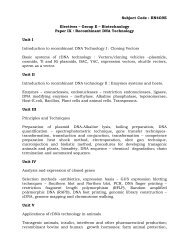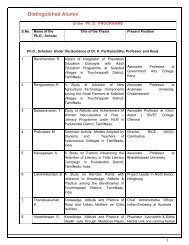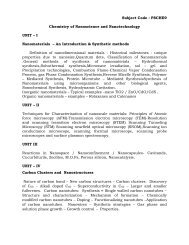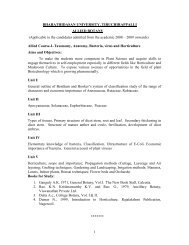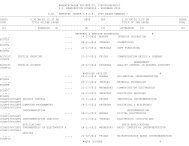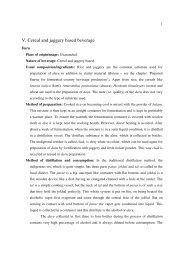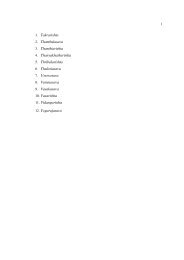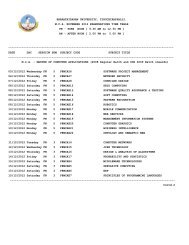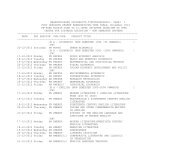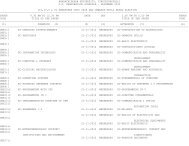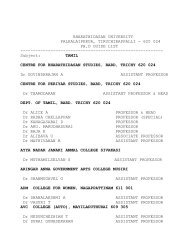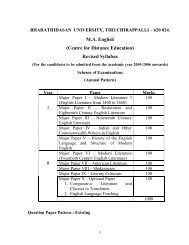Subject Code : P8BT3 CORE COURSE III – MICROBIOLOGY Unit I ...
Subject Code : P8BT3 CORE COURSE III – MICROBIOLOGY Unit I ...
Subject Code : P8BT3 CORE COURSE III – MICROBIOLOGY Unit I ...
You also want an ePaper? Increase the reach of your titles
YUMPU automatically turns print PDFs into web optimized ePapers that Google loves.
<strong>Unit</strong> I<br />
<strong>CORE</strong> <strong>COURSE</strong> <strong>III</strong> <strong>–</strong> <strong>MICROBIOLOGY</strong><br />
<strong>Subject</strong> <strong>Code</strong> : <strong>P8BT3</strong><br />
Discovery of Microbes <strong>–</strong> contribution of various scientists and Development of<br />
Microbiology in twentieth century, Classification and characteristic features of<br />
Micro organisms(eubacteria, archae, fungi, algae, protozoa and viruses) <strong>–</strong><br />
Concept of tasa, species, strain, nomenclature and Bergey’s manual,<br />
Classification of bacteria bases on morphology (shape and flagella), staining<br />
reaction, nutrition and extreme environment). Bacterial taxonomy <strong>–</strong> New<br />
approach. Importance and Scope of Microbial technology.<br />
<strong>Unit</strong> II<br />
Bacterial respiration <strong>–</strong> aerobic and anaerobic, bacterial photosynthesis and<br />
reproduction <strong>–</strong> asexual and sexual, genetics. Bacterial growth and nutritional<br />
requirements, Growth curve, measurement of growth, types of media and<br />
preparation of ordinary and special media <strong>–</strong> methods of preservation and<br />
storage of microbes. Culture of viruses. Current methods of microbial<br />
identification<br />
<strong>Unit</strong> <strong>III</strong><br />
Antimicrobial agents <strong>–</strong> Physical and chemical, Antibiotics (each with one<br />
example) affecting cell membrane, nucleic acid synthesis, protein synthesis and<br />
metabolism, Mode of action <strong>–</strong> Kinds of side effects <strong>–</strong> Antifungal and antiviral<br />
drugs, Mechanisms of drug resistance, Bioactive natural products (anti-<br />
bacterial, anti-fungal, anti-viral) from macroalgae, marine bacteria,<br />
dinoflagellates etc.<br />
<strong>Unit</strong> IV<br />
Biofertilizers <strong>–</strong> Mechanism of nitrogen fixation and its uses. Bioinsecticides<br />
Mycoinsecticides <strong>–</strong> advantages and mode of action <strong>–</strong> Bacillus thuringiensis,<br />
Baculo viruses, NPV- Biodegradation of xenobiotics, Bio leaching <strong>–</strong>principle and<br />
method <strong>–</strong> advantages and chemical reaction, Biodetoriation, Bioremediation,<br />
Biosurfactants, Bioventing, Biospraying, Phytoremediation, Microbes in<br />
petroleum extraction. Applying of microbial biotechnology in sewage and waste<br />
and water treatment.
<strong>Unit</strong> V<br />
Microbial fermentation- Bread, Beer, Wine, Cheese, Vinegar, fermented<br />
vegetables, SCP, Alcohol, Acetic acid, fermented Milk and other products <strong>–</strong><br />
Spoilage microbes and means of controlling the (Physical and Chemical<br />
means).<br />
Production of useful products <strong>–</strong> Antibiotics, Amino acids, vitamins, solvents,<br />
vaccines, enzymes, extremozymes from extremophiles <strong>–</strong> its biotechnological<br />
application, Bioenergy, biopolymer and bioplastics production.<br />
Text Book:<br />
1. Glazer and Nikaido, (2007), Microbial Biotechnology, II edition, Cambridge<br />
University Press<br />
Reference Books:<br />
1. Alexander M. (1977) Introduction to Soil Microbiology, John Wiley & Sons,<br />
New York<br />
2. Ronald M. Atlas, Richard Bartha R., (2004), Microbial Ecology <strong>–</strong><br />
Fundamentals and applications, Pearson education Limited<br />
3. Pelzer M.J. Jr., Chan. E.C.S. and Kreig N.R. (1993), Microbiology, McGraw<br />
Hill Inc. New York<br />
4. Salle A.J. (1999), Fundamental Principles of Bacteriology, fifth edition Tata<br />
McGraw <strong>–</strong> Hill Publishing Company Limited, New York.<br />
5. Adams, Martin, R. Moss., Maurice O. (2004) Food Microbiology, Third<br />
edition, Royal Society of Chemistry, Cambridge<br />
6. Frazier WC. And Wean hoff DC., (1998), Food Microbiology, Tata McGraw<br />
Hill Publishing Company Limited, New Delhi<br />
7. Baily, J.E..and Ollis, D.F. (1986), Biochemical Engineering Fundamentals,<br />
Mc Graw Hill, New York<br />
8. Balasubramanian, D. and Bryce, C.F.A. Jeyaraman, K. Dharmalingam K.<br />
Green (2004) Concepts in Biotechnology, COSTED-IBN, University Press,<br />
Hyderabad<br />
9. Flickinger M.C. & Drew S.W. (1999) Encyclopedia of Bioprocess Technology<br />
<strong>–</strong> Fermentation Biocatalysis and Bioseperation, (Volumes I <strong>–</strong> V), John Wiley<br />
and Sons , Inc., New York<br />
10. Stanbury P.F. & Whitaker. A. and S.J. Hall (2003), Principles of<br />
Fermentation Technology, Butterworth <strong>–</strong> Heineman, New Delhi<br />
11. Jacquelyn G. Black, (2008), Microbiology Principles & Explorations,<br />
Seventh Edition<br />
12. Brenner, D.J. Kreig, N.R. Staley, J.T., (eds.) (2005), Bergey’s manual of<br />
systematic bacteriology, Vol.II edition, New York, Springer<br />
13. P.S. Bisen, (1994) Frontiers in Microbial Technology, CBS Publishers, Delhi<br />
14. Gerard. J. Tortora, Berdell R. Funke, Christian L. Case, (2006),<br />
Microbiology: An introduction, ninth edition, Benjamin Cummings<br />
Publications


